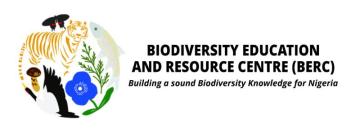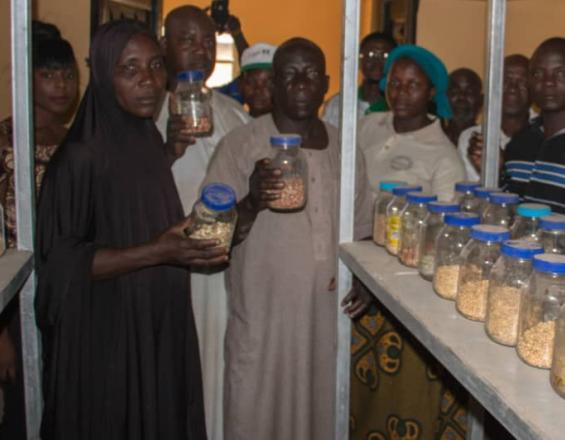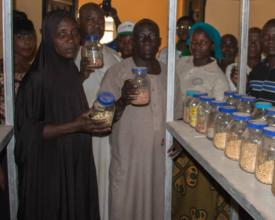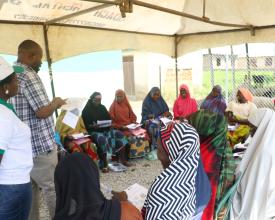
Asegurar la base de recursos genéticos de las especies vegetales autóctonas: Una iniciativa comunitaria de conservación de la biodiversidad

Hemos ayudado a las comunidades a desarrollar huertos domésticos de importantes especies de plantas silvestres. Nuestra rentable iniciativa de conservación de semillas y genes ha ayudado a las comunidades a conservar, restaurar y revitalizar especies y variedades de cultivos locales fundamentales para la supervivencia de la comunidad.
Contexto
Défis à relever
La biodiversidad es fundamental para la seguridad alimentaria y la nutrición. Lamentablemente, el impacto humano está acelerando su pérdida. Las plantas autóctonas tienen el potencial de aumentar la seguridad alimentaria/nutrición y la conservación de la biodiversidad debido a su contribución potencial en la prevención de la malnutrición, la obesidad y los trastornos relacionados con la dieta. Lamentablemente, la mayoría de ellas están localizadas e incluso pueden extinguirse antes de ser descubiertas, desapareciendo con ellas su enorme conocimiento indígena.
Ubicación
Procesar
Resumen del proceso
Nuestro enfoque conecta de una manera única, ya que hemos sido capaces de conectar a las comunidades con la conservación de las plantas autóctonas. Al promover la conservación de las plantas autóctonas, hemos ofrecido oportunidades de gestión forestal responsable y desarrollo empresarial a nivel comunitario. Así, armados con estas herramientas, los miembros de la comunidad pudieron cumplir las especificaciones/requisitos de la industria y acceder a nuevos mercados. En total, hemos creado una base local de ecosistemas sanos que ha facilitado enormemente el crecimiento económico no sólo dentro de la Comunidad Forestal, sino más allá de la comunidad a través del comercio de productos. Con técnicas de envasado decentes, los productos locales se han vendido incluso en las estanterías de los grandes centros comerciales de las zonas urbanas. Esto ha garantizado que los productos de la biodiversidad local sean comercializables.
Bloques de construcción
Asegurar la base de recursos genéticos de las especies vegetales autóctonas: Una iniciativa comunitaria de conservación de la biodiversidad
Hemos elaborado un manual que puede ayudar a las pequeñas agricultoras a reproducir las soluciones en el suroeste de Nigeria. A nivel nacional, colaboramos con los responsables políticos para incluir las plantas alimenticias autóctonas como componentes clave de los programas de alimentación escolar, así como del programa de microcréditos Anchor borrowers. Nuestros programas de jornadas de puertas abiertas de bancos de semillas proporcionan vías para el intercambio y la exhibición de la diversidad de semillas, así como un modelo para la ampliación de los bancos de semillas locales a un proyecto nacional para la conservación de un mayor número de parientes de cultivos silvestres en Nigeria. Actualmente estamos abogando en la legislatura nacional para que se promulguen leyes sobre la inclusión de plantas alimenticias autóctonas en el programa de política alimentaria de Nigeria. Todas estas iniciativas contribuirán significativamente a la conservación de las especies vegetales autóctonas.
Factores facilitadores
Con un acceso limitado a la tierra, las mujeres siguen siendo custodias de la biodiversidad con conocimientos para reforzar la seguridad alimentaria. El 65% de los miembros de la comunidad participantes eran mujeres. El 53% tenía entre 40 y 65 años y el 47% entre 18 y 39 años. La participación de las mujeres contó con el apoyo de sus maridos. De este modo, más mujeres tomaron decisiones sobre las necesidades alimentarias de sus familias y participaron activamente en la gestión y el reparto de beneficios.
Lección aprendida
Los hogares crearon pequeñas y medianas empresas para lograr un crecimiento económico constante que redujera la presión sobre el bosque circundante. Como consecuencia de la menor presión sobre el bosque para su subsistencia, han surgido nuevas fuentes de ingresos. Los ecosistemas locales de base han facilitado el crecimiento no sólo dentro de la Comunidad Forestal sino más allá, creando oportunidades de trabajo digno. Lograr la inclusión social fue hacer hincapié en la "propiedad local". La creación de espacios de diálogo que permitieran la participación activa e integradora de la población local garantizó que las prioridades se determinaran localmente y que las preocupaciones locales estuvieran en el centro de todas las actividades.
Asegurar la base de recursos genéticos de las especies vegetales autóctonas: Una iniciativa comunitaria de conservación de la biodiversidad
El proyecto proporcionó fuentes alternativas de propagación (huertos domésticos para 500 hogares en 5 pueblos) aumentando la diversidad en torno a la comunidad forestal y reduciendo al mismo tiempo la presión sobre el bosque para estas especies. Se guardaron 175 variedades de 35 especies de cultivos en el banco de semillas comunitario. Las actividades de intercambio y multiplicación de semillas influyeron en el aumento del cultivo de nuevas variedades. El banco de semillas produjo y vendió más de 10 variedades diferentes de tomates, ñames y huevos de huerta locales. Los ingresos se utilizaron para crear un Fondo Comunitario de Gestión de la Biodiversidad.
Factores facilitadores
Nuestro proyecto está restaurando la biodiversidad de plantas autóctonas en torno a las comunidades forestales de Nigeria, donde se han agotado con el tiempo debido a la sobreexplotación, además de contribuir a preservar las variedades de plantas tradicionales y las reservas de genes silvestres para los pueblos indígenas. Nuestro proyecto ha proporcionado fuentes alternativas de propagación, aumentando la diversidad en torno a las comunidades forestales y reduciendo al mismo tiempo la presión sobre el bosque para estas especies.
Lección aprendida
Hemos demostrado que existe un vínculo entre la buena nutrición que aportan estas plantas autóctonas y la salud del medio ambiente y los bosques que rodean a estas comunidades. Independientemente de los efectos de la pandemia de COVID-19 en nuestros sistemas alimentarios, las semillas conservadas en el banco de semillas comunitario han podido garantizar la continuidad del suministro y la distribución de semillas, lo que ha supuesto un gran impulso para la creación de sistemas alimentarios locales resistentes en la comunidad.
Impactos
La biodiversidad es fundamental para la seguridad alimentaria y la nutrición. Las plantas autóctonas tienen el potencial de aumentar la seguridad alimentaria/nutrición y la conservación de la biodiversidad debido a su posible contribución a la prevención de la malnutrición, la obesidad y los trastornos relacionados con la dieta. Lamentablemente, la mayoría de ellas están localizadas y pueden incluso extinguirse antes de ser descubiertas, desapareciendo con ellas su enorme conocimiento indígena. estamos creando resiliencia comunitaria teniendo en cuenta el conocimiento indígena que a lo largo del tiempo ha desempeñado un papel importante en la configuración de su existencia. De este modo, las comunidades han hecho frente a las amenazas a la seguridad alimentaria/nutricional y a la pérdida de biodiversidad reduciendo la venerabilidad. Al maximizar el potencial de las especies alimentarias autóctonas, hemos fomentado la confianza y la percepción de la comunidad sobre los factores socioeconómicos de su entorno que influyen en su actitud/comportamiento. Hemos demostrado que existe un vínculo entre la buena nutrición que aportan estas plantas autóctonas y la salud del medio ambiente y los bosques que rodean a estas comunidades. Independientemente de los efectos de la pandemia de COVID-19 en nuestros sistemas alimentarios, las semillas conservadas en el Banco Comunitario de Semillas pudieron garantizar la continuidad en el suministro y la distribución de semillas, lo que supuso un gran impulso para la creación de sistemas alimentarios locales resistentes en la comunidad.
Beneficiarios
Hemos desarrollado huertos familiares para importantes especies de plantas silvestres. Nuestra rentable iniciativa de conservación de semillas y genes ha ayudado a las comunidades a conservar, restaurar y revitalizar especies y variedades de cultivos locales fundamentales para la supervivencia de la comunidad.
Objetivos de Desarrollo Sostenible
Historia
De pequeño, siempre me ha sorprendido cómo Charles Darwin llegó a sus teorías. Me he dado cuenta de que sus teorías no se basaban en grandes conocimientos académicos, sino en el simple hecho de su "AMOR por la NATURALEZA", complementado por sus "INSTINTOS NATURALES" de observación. Al crecer, descubrí que yo también sentía pasión por la conservación de la naturaleza y mi formación como científico de las plantas aumentó mis habilidades para el seguimiento de la biodiversidad de la flora. En mi afán por ser un "mejor naturalista", empecé a interesarme por la comunicación de temas relacionados con la biodiversidad a la población local. Estos fueron los momentos "Aha" que me llevaron a mis objetivos de ciencia para el desarrollo comunitario. Quiero que mis proyectos de investigación no sólo tengan repercusiones científicas, sino también de desarrollo de la comunidad rural.





